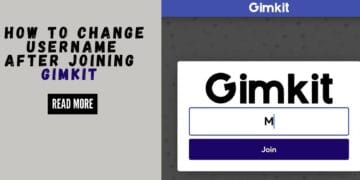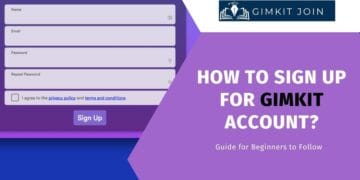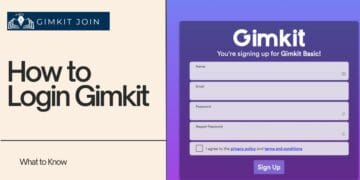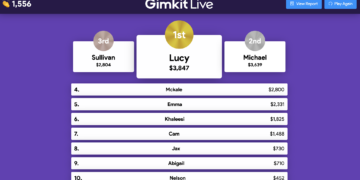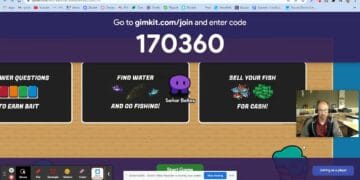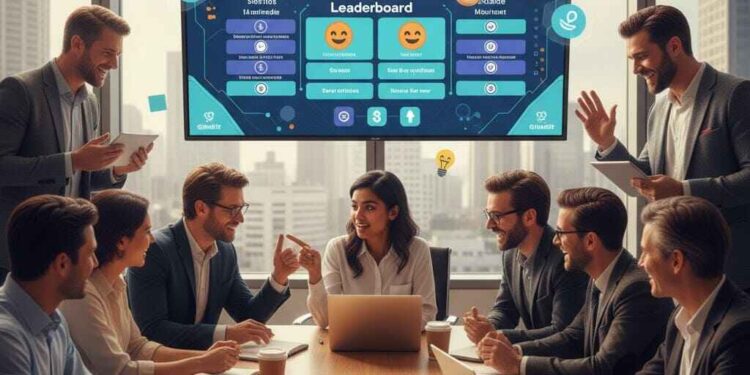Executive Summary: The Business Case for Gamified Sales Training
As a Sales Enablement Manager or VP of Sales, you know the single most expensive bottleneck in your organization is ramp time—the period from hiring a new sales representative to consistently hitting quota. Traditional training, with its endless PowerPoints and tedious compliance modules, is failing to prepare your team for the complex, competitive reality of B2B selling.
This is where Gimkit for sales training steps in.
By transforming mandatory learning into a competitive, high-engagement game show, Gimkit taps into the natural motivation of sales professionals—competition and achievement.
- The Problem: Low engagement, information overload, and poor knowledge retention, costing you months of lost revenue.
- The Solution: Gamified sales onboarding and continuous training using tools like Gimkit, which leverages spaced repetition and competitive dynamics.
- The Impact: Companies utilizing gamified training report a 15% to 20% boost in performance and can see a significant reduction in ramp time, directly impacting your quota attainment and revenue operations.
This guide is your practical playbook for implementing Gimkit into your sales enablement strategy, complete with metrics, use cases, and an ROI framework.
- Why Traditional Sales Training is Failing Your Bottom Line
If your sales team’s primary exposure to new product knowledge is a 4-hour video or a 100-slide deck, you’re not training them—you’re setting them up for a knowledge retention crisis.
Traditional, passive training methods create three critical revenue gaps:
1.1. The Engagement and Retention Crisis
 The average attention span for a dense, text-heavy training session is low. Sales professionals are kinetic, competitive, and results-oriented. They do not thrive in a passive learning environment.
The average attention span for a dense, text-heavy training session is low. Sales professionals are kinetic, competitive, and results-oriented. They do not thrive in a passive learning environment.
- Information Overload: Dumping a massive sales playbook on a new hire leads to the Ebbinghaus Forgetting Curve, where up to 70% of new information is forgotten within a day.
- Lack of Relevance: Long modules often cover concepts irrelevant to a rep’s immediate needs, delaying their ability to conduct a successful first call.
- Delayed Feedback: Reps only find out their product knowledge is weak during a live customer call—the worst possible time.
1.2. The High Cost of a Long Ramp Time
 The true cost of a new hire isn’t just their salary; it’s the revenue they aren’t generating while they’re ramping up.
The true cost of a new hire isn’t just their salary; it’s the revenue they aren’t generating while they’re ramping up.
Sales Leader Tip: Every month you shave off the average ramp time for a new hire is a month of full quota attainment you gain back, dramatically improving your sales velocity.
If your average time-to-quota is six months, and gamified sales team training games can cut that by two months, you unlock $X in additional revenue per rep, per year. This is the core ROI of gamified sales onboarding.
1.3. The Challenge of Remote and Hybrid Training
 In today’s remote sales training and hybrid workforce training environment, getting geographically dispersed reps together for in-person training is costly and inefficient. You need interactive sales training tools that are mobile-friendly, asynchronous, and equally engaging, regardless of where your team is located.
In today’s remote sales training and hybrid workforce training environment, getting geographically dispersed reps together for in-person training is costly and inefficient. You need interactive sales training tools that are mobile-friendly, asynchronous, and equally engaging, regardless of where your team is located.
- Gimkit: The Modern Weapon for Sales Enablement
Gimkit, originally designed for education, is proving to be a perfect corporate training games platform due to its unique combination of game dynamics and customizable content—it is essentially a next-generation corporate microlearning tool wrapped in an arcade experience.
2.1. What Makes Gimkit Ideal for Sales Professionals?
 Sales reps are naturally driven by competition, status, and financial rewards. Gimkit leverages these intrinsic motivators:
Sales reps are naturally driven by competition, status, and financial rewards. Gimkit leverages these intrinsic motivators:
- Leaderboard Motivation: The core of Gimkit is the leaderboard, which capitalizes on the salesperson’s competitive drive. You’re not just answering a quiz; you’re earning “money” and gaining status.
- Spaced Repetition Learning: Gimkit’s mechanics require players to re-engage with questions they get wrong (often with a penalty), naturally reinforcing concepts over time, a core principle of sales training retention strategies.
- Microlearning for Sales: Content is delivered in short, sharp bursts (individual questions), making it an ideal strategy for product knowledge training games that fit into a busy sales rep’s calendar.
- No Admin Burden: It’s easy for sales leaders to create a Kit of questions focused on a specific challenge (like a competitive battlecard) and run a 15-minute game show session.
2.2. Key Training Challenges Gimkit Solves
| Sales Training Challenge | Gimkit Solution & Use Case | Secondary Keywords |
| Product Knowledge | New product launch training. Kit focuses on features, benefits, and common customer questions. | Product knowledge retention |
| Competitive Intelligence | “Competitive Battlecard Blitz.” Kit quizzes reps on competitor pricing, weaknesses, and key differentiators. See this guide on competitive battlecard best practices. | Competitive intelligence |
| Sales Methodology | Quizzes on the stages of the sales cycle, discovery questions (SPIN, MEDDIC). | Sales methodology training |
| CRM Proficiency | Questions on where to log activities, update the pipeline, or create a contact in Salesforce/HubSpot. | CRM familiarity |
| Objection Handling | Question: “Customer says, ‘It’s too expensive!'” Correct answer: “Value-based response.” | Objection handling practice |
3. The ROI of Gamification: Data That Revenue Leaders Demand
Does gamification work for sales training? The data says an undeniable yes. For VPs of Sales and Sales Directors focused on the bottom line, the value of Gimkit is measured in dollars and time saved. Want to see how this compares to other tools? Here’s an analysis of which is better: Gimkit or Blooket for comparison
H3 3.1. Quantifiable Benefits for Sales Enablement
| ROI Metric | Traditional Training | Gamified Training (Gimkit) | Source/Impact |
| Knowledge Retention | ~30% (after 1 week) | Up to 60% improvement (McKinsey research) | Higher confidence, better call quality. |
| Ramp Time Reduction | 6-9 Months (Industry Average) | 30-40% Reduction reported by companies using gamified learning. | Accelerated time to quota, immediate revenue gain. |
| Engagement Rate | Low (40-60% completion) | Up to 83% of employees report feeling more motivated. | Ensures content is actually consumed and applied. |
| Training Completion | ~25% (Non-gamified e-learning) | Up to 90% completion rate with gamified elements. | Compliance and policy training are actually done. |
3.1.1. Calculating Your Onboarding Acceleration ROI
 To find the ROI of using Gimkit for sales training, you can run a simple comparison:
To find the ROI of using Gimkit for sales training, you can run a simple comparison:
$$\text{Revenue Gain} = (\text{Avg. Monthly Quota}) \times (\text{Ramp Time Saved in Months}) \times (\text{Number of New Reps})$$
If your average quota is $20,000/month, and you hire 10 reps, saving 2 months of ramp time per rep yields:
$$\$20,000 \times 2 \text{ months} \times 10 \text{ reps} = \mathbf{\$400,000 \text{ in accelerated revenue}}$$
This is the power of onboarding acceleration driven by effective tools.
4. Implementation Framework: Your 30-60-90 Day Gimkit Playbook
Implementing a new tool shouldn’t disrupt your sales cycle. This framework provides a practical, three-stage plan for using Gimkit effectively in your sales rep onboarding software stack.
4.1. The 30-Day Immersion (New Hire Onboarding)
 The goal is rapid foundational knowledge and product knowledge retention.
The goal is rapid foundational knowledge and product knowledge retention.
| Activity | Gimkit Strategy | Focus |
| Week 1: Core Product & Company | Daily 15-minute Gimkit Firefight on product specs, company history, and key selling points. | Microlearning for sales |
| Week 2: Sales Playbook & Process | Team vs. Team Gimkit (The Floor is Lava mode) on CRM process, deal stages, and internal routing. | Sales playbook reinforcement |
| Week 3: Competitive Landscape | Gimkit Blitz game is focused entirely on competitive intelligence mastery. | High-stakes competitive learning. |
| Week 4: Role-Play Readiness | Gimkit “Homework” Assignments (asynchronous review) on objection handling practice scripts. | Spaced repetition reinforcement. |
4.2. The 60-Day Reinforcement (Ramp Time Reduction)
 The goal shifts from basic knowledge to active application and skill retention.
The goal shifts from basic knowledge to active application and skill retention.
- Weekly Drill Sessions (Friday Finish): Dedicate the last 20 minutes of your weekly sales meeting to a Gimkit game focused on the week’s pipeline challenges. (e.g., A rep struggled with a security objection; the new Kit is on security features).
- Pitch Practice and Role-Play Integration: Use Gimkit to quiz reps before a live role-play scenario. Only those who pass the “Product Knowledge Certification Kit” get to participate, tying Gimkit to a Sales certification program.
4.3. The 90-Day Continuous Learning (Sales Enablement Gamification)
 The goal is to drive continuous, high-performance behavior across the entire team.
The goal is to drive continuous, high-performance behavior across the entire team.
- Quota Attainment Leaderboard: Integrate Gimkit performance metrics (Kit completion, high scores) into the broader sales dashboard to reward high achievers beyond just revenue.
- New Content Launches: Every product update, new marketing campaign, or compliance module becomes an instant 10-question Gimkit game, ensuring immediate knowledge adoption across the entire team. This keeps your training evergreen content.
- Manager Coaching Scalability: Use the Gimkit reports dashboard to identify knowledge gaps before they hit the field. If three reps score low on the “Pricing Objection Kit,” you know exactly who needs targeted coaching, driving sales coaching scalability.
- Specific Gimkit Use Cases That Drive Sales Results
“How to gamify sales training?” The key is mapping Gimkit’s game modes to specific sales challenges.
5.1. Product Launch Mastery (The “Trust” Signal)
 When launching a new product, sales reps need to sound confident and authoritative.
When launching a new product, sales reps need to sound confident and authoritative.
- The Game: Gimkit’s Trust No One mode.
- The Content: Highly specific, technical facts about the new product, use cases, and the “killer feature” comparison to the competition.
- The Result: Forces reps to memorize facts under pressure, preventing the embarrassment of getting caught on a feature detail during a live demo.
5.2. Competitive Battlecard Reinforcement (The “Win” Signal)
 Sales reps need to be able to instantly pivot when a competitor is mentioned.
Sales reps need to be able to instantly pivot when a competitor is mentioned.
- The Game: Gimkit’s Infinity Mode (or classic Gimkit).
- The Content: Questions are phrased as direct comparisons: “Competitor X’s primary weakness is…” or “Which competitor does not offer [Feature Y]?”
- The Result: Fast, instinctive recall of competitive intelligence, leading to sharper, more aggressive, and more effective pitches.
5.3. Team-Building & Culture (The “Retention” Signal)
 Onboarding is also about assimilation into the culture.
Onboarding is also about assimilation into the culture.
- The Game: Team Mode or Fishtopia.
- The Content: Lighthearted trivia about company values, leadership bios, internal department functions (e.g., “Who leads the Revenue Operations team?”), and company history.
- The Result: Builds team camaraderie, fosters a continuous learning culture, and helps new hires quickly learn who to go to for help, supporting team-building activities.
- Implementation Checklist: Making Gimkit Work for Your Business
For Sales Enablement Managers ready to dive in, here is a quick-start guide to ensure you maximize your investment in an affordable sales training software for small teams (and big ones!).
6.1. Best Practices for Gimkit Question Design
- Focus on Application, Not Memorization: Don’t ask, “What is the third step of the MEDDIC process?” Ask, “A prospect just mentioned budget is a concern. Which part of MEDDIC should you focus on next?”
- Use Visuals: Use the image upload feature for questions on competitor UI screenshots, product feature diagrams, or internal tool navigation.
- Keep Kits Focused: A single Kit should cover one specific competency (e.g., “Q2 Product Pricing” or “Salesforce Data Entry Best Practices”).
6.2. Metrics Dashboard: What to Track for ROI
| Metric to Track | Data Source | Business Impact |
| Kit Score/Accuracy | Gimkit Reports | Knowledge retention metrics identify individual learning gaps. |
| Completion Rate | Gimkit Reports | Training engagement and compliance. |
| Time-to-First-Deal | CRM (Salesforce/HubSpot) | Ramp time reduction; correlation with high Gimkit scores. |
| Quota Attainment % | CRM/Sales Ops | Overall program success: links training directly to revenue. |
| Objection Handling Success Rate | Call Recordings/Coaching Tool | Improved pitch practice and role-play efficacy. |
6.3. Affordable Alternatives and Comparison
While Gimkit is excellent for rapid-fire, competitive, and knowledge-retention-focused training, it may not replace your heavy-duty LMS (Learning Management System).
| Platform Type | Primary Use Case | Gimkit Role/Advantage |
| LMS (e.g., Cornerstone, SAP) | Compliance, HR modules, long-form certification. | Gimkit is the ‘active application’ layer. It reinforces the dry content delivered in the LMS. |
| Sales Readiness Platform (e.g., Mindtickle) | Pitch practice, video role-play, peer-to-peer feedback. | Gimkit is the affordable alternative for testing core declarative knowledge before practice. |
7. Conclusion: The Future of Your Sales Training is Gamified
Your team is your engine for revenue growth. Investing in the right tools to accelerate their performance is not an expense—it’s the fastest path to increasing your quota attainment. For those new to the platform, we have a simple guide to signing up for a Gimkit account.
By integrating Gimkit for sales training into your enablement stack, you move past the passive training methods of the past and embrace a system built on motivation, competition, and measurable results. You will empower your reps with the deep, fast-recall knowledge they need to win more deals and drastically reduce sales onboarding time.
It’s time to stop hoping your team knows the material and start proving it with data-driven gamification sales onboarding.
Frequently Asked Questions (FAQ) for Sales Leaders
How can Gimkit for corporate training programs handle sensitive data?
Gimkit is primarily a quiz-and-game platform. You should use it to quiz on publicly available product knowledge retention facts or general sales process knowledge, not sensitive PII. For corporate accounts, use it as a highly engaging quiz wrapper for content hosted on a secure LMS.
Is Gimkit really an affordable sales training software for small teams?
Yes. Compared to enterprise-level sales readiness platforms that cost thousands per user per year, Gimkit's pricing model is significantly more accessible, making it an excellent, low-risk tool for startups and growing small businesses that need to quickly figure out how to train sales reps with games.
How do I ensure older, more experienced reps engage with the games?
Frame it as a mandatory Sales certification program or a competitive Team-building activity with tangible, desirable rewards (e.g., an extra PTO day, a gift card, or even just public recognition from the VP of Sales). The competitive element alone often motivates the most experienced salespeople.





